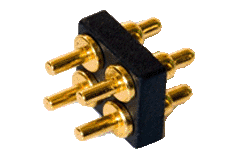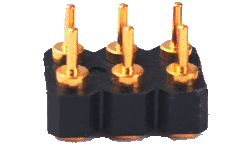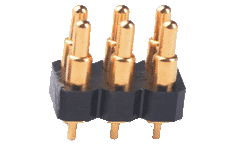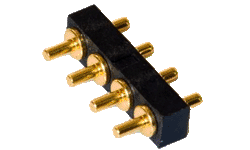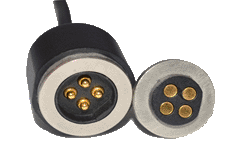2025-2-20 15:52:24
Detailed Analysis of Why Pogo Pins Heat Up
Pogo Pins, also known as spring-loaded connectors, are precision connectors widely used in electronic devices. With their unique spring design and high flexibility, they play a crucial role in charging and data transmission. However, users may encounter heating issues when using
Pogo Pin. So, why do Pogo Pins heat up? The following is a detailed analysis from multiple aspects.
I. Basic Structure and Working Principle of Pogo Pins
Pogo Pins mainly consist of a plunger, tip, spring, and housing. Their working principle is to use the spring's elastic force to keep the tip in good contact with the contact surface, thereby enabling the transmission of electrical signals or currents. Due to their retractable nature, Pogo Pins can adapt to devices of different thicknesses and shapes for connection.
II. Reasons for Pogo Pin Heating
1. Thermal Effect Generated by Current Flow
When current passes through a Pogo Pin, a certain amount of heat is generated due to the presence of resistance. This is a physical phenomenon that occurs when current flows through any conductor. As the current increases, the amount of heat generated also increases. Especially in high-current applications, such as fast charging, the heating issue of Pogo Pins is particularly prominent.
2. Increased Resistance Due to Poor Contact
If there is poor contact between the tip of the Pogo Pin and the contact surface, such as contaminants like oxides or dust adhering to the contact surface, or a mismatch in the shape of the tip and the contact surface, the contact resistance will increase. An increase in contact resistance will result in more heat generation under the same current, leading to heating of the Pogo Pin.
3. Spring Fatigue and Decrease in Elasticity
The spring is one of the core components of a Pogo Pin, responsible for providing the elastic force to keep the tip in good contact with the contact surface. However, as usage time increases, the spring may lose its original elasticity due to fatigue. This will result in insufficient contact pressure between the tip and the contact surface, thereby increasing the contact resistance and generating more heat.
4. Material and Plating Process Issues
The tip and plunger of a Pogo Pin are typically made of metal materials such as brass. These metal materials are prone to oxidation in the air, forming a layer of oxide film. The presence of the oxide film will increase the contact resistance, leading to heating. To address this issue, Pogo Pins are usually plated, such as with gold or silver. However, if the plating process is poor, such as uneven plating thickness or poor adhesion of the plating layer, it will also result in increased contact resistance and heating.
5. Influence of Environmental Factors
The usage environment of Pogo Pins can also affect their heating. For example, using Pogo Pins in high-temperature environments will accelerate the accumulation and dissipation of heat, making the heating more severe. Additionally, if Pogo Pins are exposed to harsh environments such as humidity or corrosive gases for a long time, it will accelerate their aging and damage, leading to heating issues.
III. Measures to Address Pogo Pin Heating Issues
1. Optimize Circuit Design
In circuit design, the current flowing through the Pogo Pins should be reasonably controlled to avoid using them as the main current transmission path in high-current applications. Furthermore, multiple Pogo Pins can be connected in parallel to distribute the current and reduce the load on individual Pogo Pins.
2. Strengthen Cleaning and Maintenance
Regularly clean and maintain the Pogo Pins to remove contaminants and oxide films on the contact surfaces, ensuring good contact between the tip and the contact surface. Additionally, lubrication can be applied to the Pogo Pins to reduce contact resistance and frictional resistance.
3. Choose High-Quality Pogo Pins
When purchasing Pogo Pins, select products with reliable quality and stable performance. Particular attention should be paid to aspects such as the elasticity and lifespan of the spring, as well as the material and plating process of the tip and plunger. High-quality Pogo Pins can better withstand currents and mechanical stresses, reducing the risk of heating and damage.
4. Improve the Usage Environment
When using Pogo Pins, it is best to avoid exposing them to harsh environments such as high temperatures, humidity, or corrosive gases. If unavoidable, corresponding protective measures can be taken, such as installing cooling devices or using sealing covers.
5. Monitoring and Early Warning
In practical applications, the heating situation of Pogo Pins can be monitored in real-time and early warnings can be provided. Temperature sensors can be installed to detect changes in the temperature of the Pogo Pins, and measures such as sounding alarms or automatically cutting off the power supply can be taken when the temperature is too high to avoid overheating damage.
In summary, the reasons for Pogo Pin heating are multifaceted and require comprehensive consideration and resolution from aspects such as circuit design, cleaning and maintenance, product quality, usage environment, and monitoring and early warning. By adopting reasonable measures and methods, the heating issue of Pogo Pins can be effectively reduced, improving their reliability and service life.


